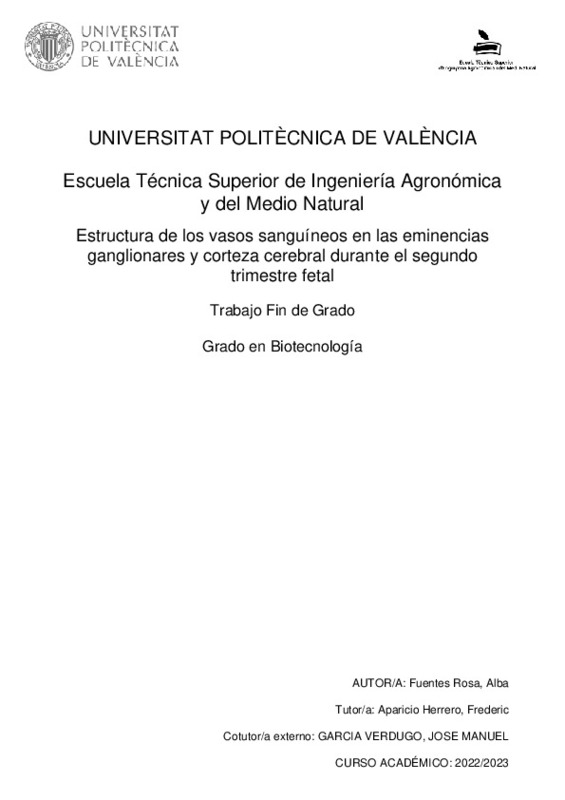|
Resumen:
|
[ES] El presente trabajo trata sobre el ana¿lisis de la estructura de los vasos sangui¿neos en las eminencias ganglionares y en la corteza cerebral de fetos de 17 y 21 semanas gestacionales. Los vasos sangui¿neos se forman ...[+]
[ES] El presente trabajo trata sobre el ana¿lisis de la estructura de los vasos sangui¿neos en las eminencias ganglionares y en la corteza cerebral de fetos de 17 y 21 semanas gestacionales. Los vasos sangui¿neos se forman mediante dos mecanismos, vasculoge¿nesis y angioge¿nesis; la angioge¿nesis es el proceso que se da en el cerebro en desarrollo mediante el cual se generan nuevos vasos a partir de otros preexistentes. En la generacio¿n de un nuevo plexo vascular es fundamental la interaccio¿n, entre al menos, dos tipos celulares, las ce¿lulas endoteliales y las murales (pericitos). Las ce¿lulas endoteliales son ce¿lulas que surgen del mesodermo esplancnopleurico, y forman el revestimiento interno de los vasos sangui¿neos, controlando asi¿ el flujo sangui¿neo y la respuesta inmunitaria. Los pericitos son ce¿lulas del tejido conectivo, que no presentan una clara ontogenia y que se localizan en el exterior de los vasos. Este tipo celular se encuentra envuelto en una la¿mina basal continua a la la¿mina basal que recubre las ce¿lulas endoteliales. Un objetivo de este trabajo sera¿ describir la organizacio¿n vascular en dos edades del desarrollo telencefa¿lico, asi¿ como las interacciones con el entorno.
Los vasos sangui¿neos que vamos a estudiar se encuentran en la zona ventricular y subventricular de las eminencias ganglionares, tanto lateral como medial y de la corteza cerebral de fetos en el segundo trimestre gestacional. Las eminencias ganglionares son importantes estructuras transitorias y proliferativas que se localizan en la pared lateral de las astas frontales de los ventri¿culos laterales. Cabe destacar que contienen una importante cantidad de precursores neuronales y que son responsables de la produccio¿n de la mayori¿a de las interneuronas inhibidoras que migran hacia la corteza cerebral.
Fallos en la formacio¿n del plexo vascular puede dar lugar a la formacio¿n de vasos sangui¿neos hemorra¿gicos e hiperdilatados, ocasionando edemas, retinopati¿as diabe¿ticas e incluso letalidad embrionaria. Por ello, este trabajo tiene como objetivo aumentar el conocimiento que se dispone sobre la ultraestructura que presentan los vasos en estas tempranas edades, asi¿ como poder obtener informacio¿n sobre el proceso mediante el cual se forman, ya que se desconoce en la actualidad.
Para ello se han utilizado cerebros de fetos de 17 y 21 semanas gestacionales siguiendo las normas establecidas por el Hospital Universitario y Polite¿cnica de la Fe. De estas muestras se obtuvieron cortes semifinos y cortes ultrafinos, para poder ser visualizados y fotografiados en el microscopio o¿ptico y en el microscopio electro¿nico, respectivamente. Con estos resultados se han analizado las principales caracteri¿sticas que presentan los vasos en las eminencias ganglionares y en la corteza, y se ha podido obtener ma¿s informacio¿n sobre el crecimiento de estos.
Este trabajo se relaciona con los siguientes ODS de la Agenda 2030: Salud y Bienestar.
[-]
[EN] This paper is about the analysis of the structure of blood vessels in the ganglionic eminences and cerebral cortex of fetuses of 17 and 21 gestational weeks. Blood vessels are formed by two mechanisms, vasculogenesis ...[+]
[EN] This paper is about the analysis of the structure of blood vessels in the ganglionic eminences and cerebral cortex of fetuses of 17 and 21 gestational weeks. Blood vessels are formed by two mechanisms, vasculogenesis and angiogenesis; angiogenesis is the process that occurs in the developing brain by which new vessels are generated from pre-existing ones. The interaction between at least two cell types, endothelial cells, and mural cells (pericytes), is essential for the generation of a new vascular plexus.
Endothelial cells are cells that arise from the splanchnopleural mesoderm, and form the inner lining of blood vessels, controlling blood flow and immune response. Pericytes are connective tissue cells, which have no clear ontogeny and are located on the outside of vessels. This cell type is enveloped in a basal lamina that is continuous with the basal lamina that covers the endothelial cells. One of the aims of this work will be to describe the vascular organization at two ages of telencephalic development, as well as the interactions with the environment.
The blood vessels that we are going to study are found in the ventricular and subventricular zones of the lateral and medial ganglionic eminences and cerebral cortex of second trimester fetuses. The ganglionic eminences are important transitional and proliferative structures located in the lateral wall of the frontal horn of the lateral ventricles. They contain a large number of neuronal precursors and are responsible for the production of most of the inhibitory interneurons that migrate to the cerebral cortex.
Failures in the formation of the vascular plexus can lead to the formation of hemorrhagic and hyperdilated blood vessels, causing oedema, diabetic retinopathy, and even embryonic lethality. Therefore, the aim of this study is to increase our knowledge of the ultrastructure of the vessels at this early age, as well as to obtain information on the process by which they are formed, which is currently unknown.
For this purpose, we have used brains from 17 and 21 gestational weeks fetuses, following the standards established by the ¿Hospital Universitario y Polite¿cnica de la Fe¿. Semi-thin and ultra- thin sections were obtained from these samples, to be visualised and photographed under the optical microscope and electron microscope, respectively. With these results, the main characteristics of the vessels in the ganglionic eminences and in the cortex have been analysed, and it has been possible to obtain more information about the growth of these vessels.
This work is related to the following SDG of the 2030 Agenda: Good health and Well-being.
[-]
|







